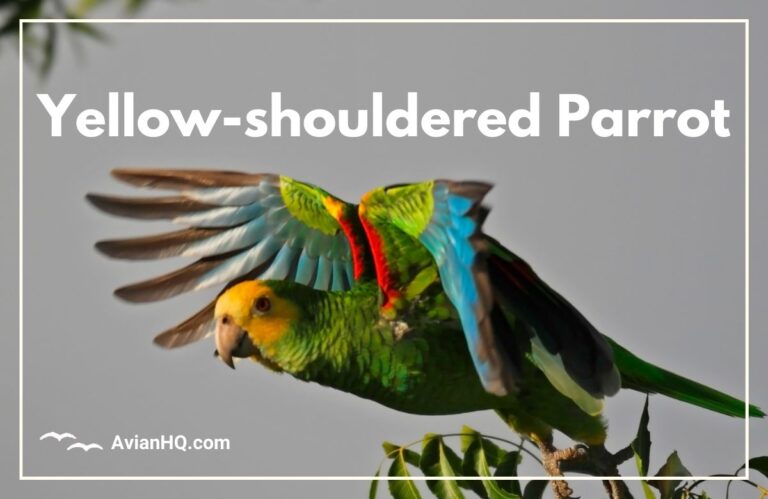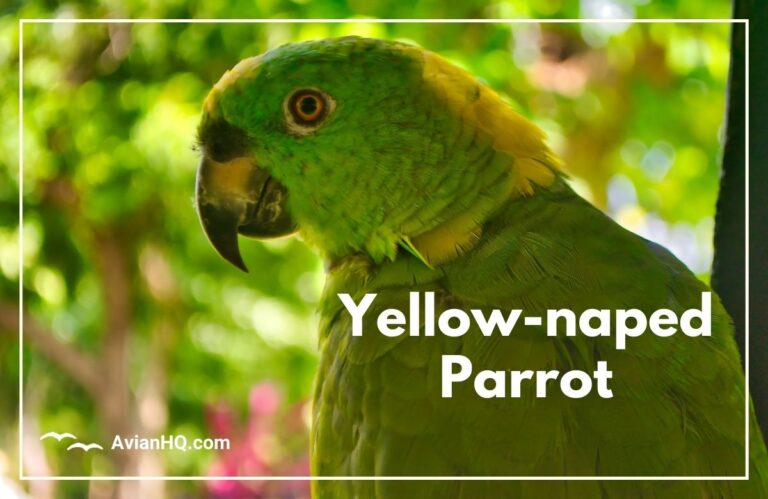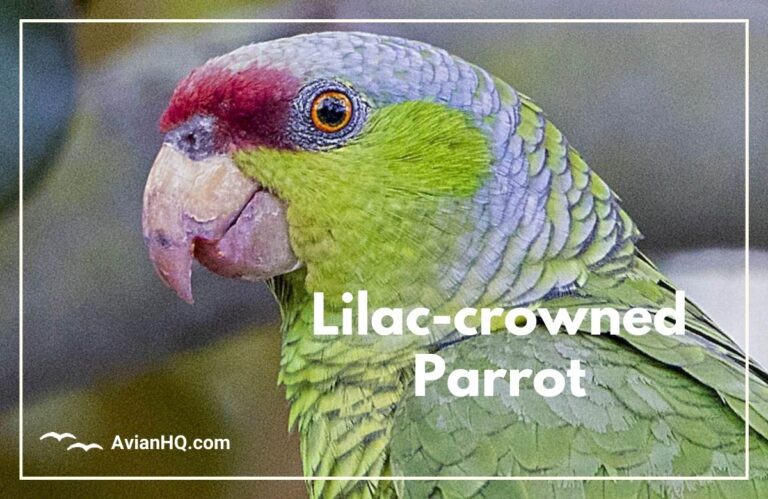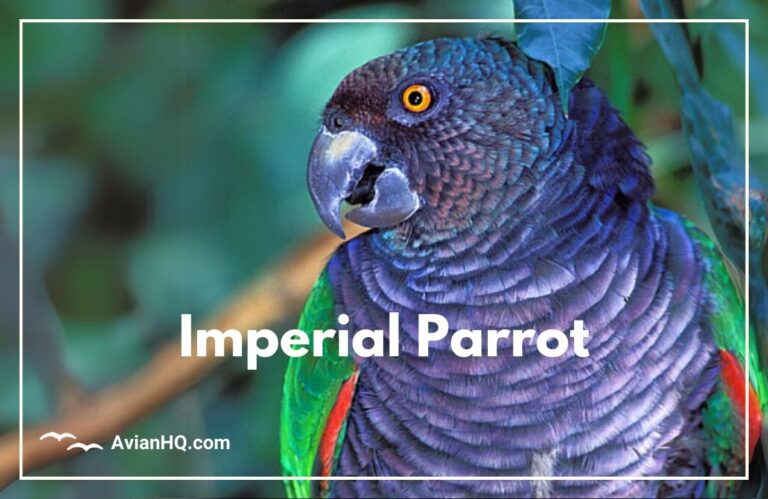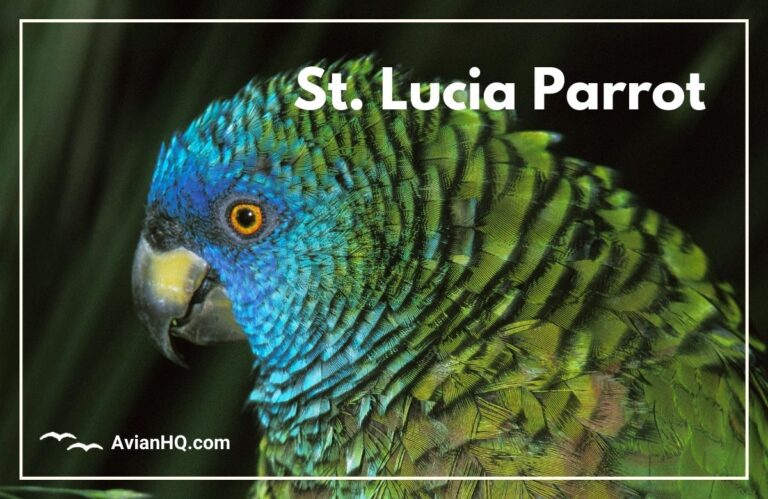Diademed Amazon Parrot (Amazona diadema)
As you gaze up into the emerald canopy of the Amazon rainforest, a flock of vibrant green parrots with flashes of red on their wings alights on a fruiting tree. These social birds are Diademed Parrots, a species endemic to a small region of northwestern Brazil.
With a length of about 13-14 inches (33-35 cm) from beak tip to tail tip, the Diademed Parrot is a mid-sized amazon parrot. It’s bright plumage and vocal nature make it a favorite among parrot enthusiasts, though it’s restricted habitat raises conservation concerns.
This article will give an in-depth look at the Diademed Parrot, covering it’s taxonomy, physical appearance, habitat range, behaviors, current threats, and cultural significance. Read on to learn more about this striking green inhabitant of Amazonia’s disappearing forests.
History and Taxonomy
The Diademed Parrot was first described scientifically in 1824 by German naturalist Johann Baptist von Spix. It’s species name, diadema, refers to the parrot’s distinctive red band across it’s forehead, resembling a diadem or crown.
For many years, the Diademed Parrot was considered to be a subspecies of the more widespread Red-lored Amazon (Amazona autumnalis), which has similar green and red plumage. However, in 2014 the Diademed Parrot was recognized as a full species, Amazona diadema, based on differences in morphology, behavior, and geographic range.
The Diademed Parrot has no identified subspecies at this time. It’s genetics and morphology are fairly uniform across the limited forests it inhabits in Brazil’s Amazonas state.
So while newly distinguished as it’s own species, the Diademed Parrot has a long history of recognition by scientists, indigenous peoples, and parrot enthusiasts as a uniquely crowned jewel of Amazonia. It’s vivid colors and loud squawks make it hard to miss in it’s treetop realm.
Physical Appearance
The Diademed Parrot is a medium-sized parrot, measuring about 13-14 inches (34-35 cm) in length from the top of it’s head to the tip of it’s tail. It weighs an average of 1-1.2 pounds (450-550 grams) as an adult.
Its predominant color is green, with a bright red band stretching across the forehead and featherless cere (skin area above the dark gray beak). The upper breast and belly are green, while the lower belly varies from deep red to yellowish-green.
The green crown, nape, and neck display black edges to the feathers. The back and upper wing feathers are also fringed in black, creating a finely scalloped effect. The primary flight feathers are dusky black, while the secondary feathers flash with brilliant blue and red at their base. The long tail is mostly green, with yellow-green tips on the outer feathers and red near the base.
The Diademed Parrot’s facial features include white bare skin encircling the eye, surrounded by small green feathers on the lores and chin. The eyes themselves have orange irises. The legs and feet are a pale gray coloration.
Males and females have identical external plumage. Juveniles look much like adults, but paler on the forehead and with dark brown instead of orange eyes. No subspecies differences have been observed within the range of the Diademed Parrot.
Habitat and Distribution
The Diademed Parrot is endemic to a small region of the Amazon basin in South America. It’s native range covers approximately 15,500 square miles (40,000 sq km) in the state of Amazonas, Brazil.
Specifically, this species inhabits lowland rainforests along the lower Rio Negro and upper Amazon River. It occupies both pristine mature forest as well as secondary forest and semi-open woodland areas. Most sightings occur at elevations below 1,000 feet (300 meters).
The Diademed Parrot has not been introduced successfully to any other geographic regions, unlike some other popular amazon parrots. Within it’s native Brazil, the parrot occurs in protected areas like the Adolfo Ducke Forest Reserve and Jaú National Park. However, it’s dependence on isolated primary rainforest makes it vulnerable to ongoing deforestation across the Amazon.
Diet and Feeding
In the wild, the Diademed Parrot feeds almost exclusively on plant materials. It’s natural diet consists mainly of fruits, nuts, seeds, and flowers.
Favorite wild foods include the fruits of the asteroids tree, palm nuts, and seeds of rainforest vegetation like Cecropia. This species favors figs in the genus Ficus above all other fruits when available.
The Diademed Parrot uses it’s strong gray beak to crack open nuts and seeds. It most often feeds while perched or clinging upright on tree branches high in the rainforest canopy. At times, groups of these parrots gather to feed communally once local fruits come into season. They show a preference for eating palm nuts alongside Red-bellied and Blue-headed macaws.
This feeding ecology concentrates feeding activity around fruiting trees across the Diademed Parrot’s fairly small habitat range. It’s bright plumage provides camouflage within the green, red, and yellow colors of ripening Amazonian fruits. But it must compete for these preferred food sources with other birds and mammals.
Breeding and Reproduction
Diademed Parrots nest in tree cavities, preferring older, mature rainforest trees. They may excavate their own nest holes or use existing hollows created by woodpeckers and natural decay. The female typically chooses the nest site, circumventing dominant males.
The breeding season for wild Diademed Parrots appears to run from January through March. Within this period, the female lays a small clutch of 2-3 white eggs. She incubates the eggs alone for about 26 days before they hatch.
The male takes on a role of feeding the female while she incubates. He also assists with feeding the chicks once they hatch, regurgitating fruit and nuts for the young to consume. Both parents display aggressive behavior towards intruders who get too close to the nest.
At around 9 weeks old, the parrot chicks are ready to leave the nest cavity. They appear identical to adults, though somewhat duller in color initially. The juveniles remain dependent on their parents for another 6-8 weeks as they learn to forage and fly competently amongst the high canopy.
Diademed Parrots are thought to reach reproductive maturity between ages 3-5 years old. In captivity, these amazons have lived for up to 60-70 years with proper care and diet. Their longevity in the wild likely depends heavily on habitat quality and pressures.
Behavior and Ecology
The Diademed Parrot exhibits highly social behaviors, especially when feeding and roosting overnight. During the day, small flocks of these parrots—numbering 5 to 30 individuals—forage for fruits and nuts high up in their forest canopy habitat.
Their loud, raucous calls ring through the trees as they squawk to communicate within their flocks. Metallic-sounding contact calls help them locate each other and may also signify warnings of potential threats.
Towards dusk, groups converge and settle into a communal roost for the night, often joining with other parrot species native to the Amazon basin. Their safety-in-numbers roosting behavior offers protection from nocturnal predators.
Diademed Parrots bathe frequently when given the opportunity. Their mating system remains unclear, but likely involves monogamous pairs bonding for each breeding season rather than lifelong. Due to limited research, additional details on their mating rituals and territoriality are still lacking.
As secondary cavity nesters, they depend on mature, old-growth rainforest trees to provide nesting sites. This species also faces pressure from a variety of native predators, including raptors and snakes that consume eggs and fledglings. Deforestation remains the most severe threat to their specialized arboreal habitat.
Conservation Status
The Diademed Parrot has a conservation status listed as “Least Concern” by the International Union for Conservation of Nature (IUCN). However, experts believe it’s restricted population is decreasing in number due to ongoing habitat pressures.
While no global population estimate exists, the density of Diademed Parrots near Manaus, Brazil was roughly 5 birds per square kilometer in the 1990s. Extrapolating out based on their limited habitat range points toward a likely total population under 10,000 individuals.
Major threats include the rampant clearing of Amazonian rainforest for agriculture, ranching, logging, and infrastructure development across Brazil. Much of it’s specialized arboreal habitat continues to disappear yearly. Trapping of these handsome parrots for the wild pet trade also impacts local populations.
Both the Adolfo Ducke Forest Reserve and Jaú National Park offer some protection, but pressure mounts along their boundaries due to expanding human settlements. More reserves like these are critically needed to preserve sufficient habitat, food sources, and nesting sites for the Diademed Parrot’s survival.
While not currently endangered, the steady deterioration of it’s home range makes proactive conservation action urgent for Brazil’s emerald crown. Loss of the Diademed Parrot would further diminish Brazil’s outstanding biodiversity.
Cultural Significance
The brilliant green and red plumage of the Diademed Parrot has made it desirable as a pet and household decoration for many years. Indigenous peoples within it’s native range traditionally kept and traded these parrots.
When Spix first described the species, he noted local tribes near the Rio Negro River referring to the parrot as “curica.” Both it’s common and scientific names reference it’s distinctive red forehead band resembling a diadem crown.
Today, domestic and international trade in wild-caught Diademed Parrots persists, often illegally. Traffickers smuggle the birds out of Brazil or sell them locally as popular cage birds. Their vocalizations and affectionate nature add to the appeal.
Around cities like Manaus, locals can often spot these green parrots with red foreheads displaying their colors as they soar over tree canopy openings. But uncontrolled trapping reduces their numbers and threatens shrinking wild populations.
While valued by people for it’s aesthetic and companionship qualities, safeguarding sustainable wild populations should take priority. As forests fall silent with loss of unique species like the Diademed Parrot, so disappears part of Brazil’s natural heritage.
Conclusion
The vibrant green and red Diademed Parrot remains little-studied compared to many other parrot species. Yet it’s restricted range within the Amazon basin forests of Brazil means protection efforts carry urgency.
With it’s extensive habitat disappearing yearly and pressure from trapping for pets, this Amazonian jewel risks decline without increased reserves and enforcement. An estimated global population below 10,000 makes it vulnerable to any disease outbreaks or environmental shifts as well.
By learning more about the Diademed Parrot through research and monitoring, people can better understand the intricacy of Brazil’s threatened ecosystems. As flocks take to the sky with flashing crimson wing feathers, this species connects us to the wonder of Amazonia’s remarkable biodiversity.
Conserving sufficient rainforest habitats ensures future generations inherit more than just stories and photographs of Brazil’s emerald crown. The vibrant calls and colors of the Diademed Parrot in thriving native forests offer living proof of nature’s resilience.


